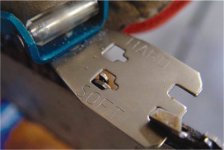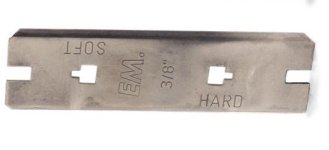I use the Stihl 2n1 sharpener when refueling. After two of these sharpening s,I put the chains into the pro Oregon and bring the teeth all back to the same
length. No matter what method that you use, you have to keep the teeth the same length along with the raker depth.
It is important to get the teeth the same length if you use a "non-progressive" depth gauge filing guide like this type sold by Oregon

The tool works by resting across two or more teeth, and measuring down from the plane established by those teeth. Since th eteeth slope back, getting shorter as you file them back, the heights can vary if you don't keep all teeth the same length. If you use the style in the bottom of the picture (with the "saddle" in the middle), the depth gauge height you get is determined by the average height of the two teeth. if you use the upper style (with the drop al the way at one end), depth gauge height is determined by the slope of the tool: if that slope is not parallel to the bar, the depth gauge height can be off significantly.
If I had to choose one of those two depth gauge tools, I'd use the type with the saddle in the middle, since the errors introduced by two teeth of unequal lengths are smaller. With the saddle on the end type, any errors are actually magnified. With either one, if you rock your chain and damage all the cutters on one side, then file them back till they are sharp again, all of the teeth on one side will be shorter in length - and thus shorter in height. Since the depth gauges are not matched specifically to their associated teeth, the teeth on one side of the chain take a bigger bite than the teeth on the other side. The saw will tend to cut in a curve. (If it gets bad enough, that curve will cause it to bind in the cut. Extended cutting under these conditions can also cause your bar to wear unevenly, contributing to cutting on a curve, even if you replace the chain with a new one.) The effect happens with either of the above depth gauge tools, but it is magnified with the "saddle on the end" type.
Since the
Stihl 2n1 (aka Pferd CS-X) sharpener works on the same principal as the "saddle in the middle" type of gauge as far as setting the heights of the depth gauges, it's susceptible to all of the same problems. (Not as bad as the saddle on the end type, but still an issue). Keeping all of the teeth the same length avoids a problem with uneven cutting.
If you use a progessive depth gauge tool, each depth gauge is tuned to the tooth immediately following it. Because of this, it's far less important that the teeth be all the same length. I still eyeball them from time to time, and may take an extra stroke or two when filing the long ones, but having exactly the same length is not necessary. Here are a couple of progressive depth gauge guides (they all rest on
one tooth, and file the depth gauge associated with that tooth):





